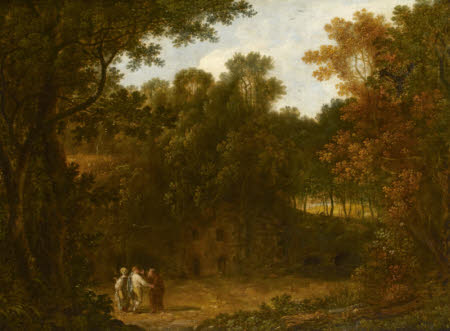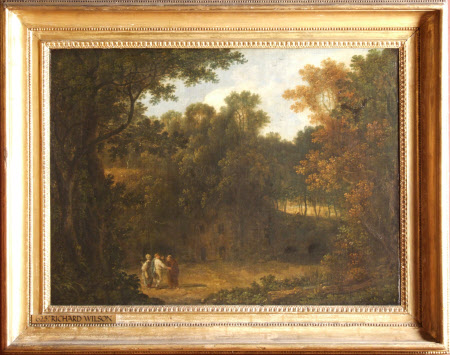The Hermitage, Villa Madama, near Rome
Richard Wilson (Penegoes 1714 - Mold 1782)
Category
Art / Oil paintings
Date
1760 (signed and dated)
Materials
Oil on canvas
Measurements
595 x 810 mm
Place of origin
England
Order this imageCollection
Petworth House and Park, West Sussex
NT 486818
Caption
Wilson had a good classical education, and the Italian countryside, together with the work of Poussin and Claude inspired him to create idyllic landscapes. He was in Rome 1752-57, but also visited Naples where he studied the classical sites. Whilst there, he made numerous drawings which he was to use on his return to England. This is a version of the painting in the collection of Lord Cobham, Hagley. The composition was called The Hermitage when exhibited in 1814, and the Villa Madama, when exhibited in 1924, and also when engraved by William Byrne (1743-1805) in 1765. It has been suggested that the engraving may have been taken from the Petworth version, which differs from the Hagley picture in details of the trees and figures.
Summary
Oil painting on canvas, The Hermitage, Villa Madama, near Rome by Richard Wilson, RA (Penegoes 1714 – Mold 1782), signed and dated: R Wilson (monogram, R reversed) 1760. A wooded lane with a man and a woman greeting a friar, on the left. The lane is to be seen running across the foreground. In the centre is a cottage overhung by trees and at right, on the top of a gentle slope, there is a line of trees against a sunset sky. The Villa Madama was designed by Raphael for Cardinal Giuliano dei Medici (later Pope Clement VII) and took its name from having been occupied by Margaret of Austria, daughter of the Emperor Charles V, and Duchess of Parma, in the late 16th century. A prime version of this scene is at Hagley Hall, Worcestershire owned by Sir George Lyttelton, who had such a building constructed in his own park. The versions have been variously also called, Il Teatro. The pastoral drama, Il Pastor Fido (1585) by G.B. Guarini (1537-1612), from which the libretto of Handel's opera is derived, was performed at the Villa Madama.
Provenance
A bill of £260 made out by 'Wm. [William] Dormer' to George O'Brien Wyndham, 3rd Earl of Egremont for five paintings and dated 15 November 1802, included a 'Landscape by Wilson' which may be this picture or one of the three other paintings by or attributed to Wilson at Petworth today; in the collection of the 3rd Earl of Egremont (1751-1837) by 1814; thence by descent, until the death in 1952 of the 3rd Lord Leconfield, who had given Petworth to the National Trust in 1947, and whose nephew and heir, John Wyndham, 6th Lord Leconfield and 1st Lord Egremont (1920-72) arranged for the acceptance of the major portion of the collections at Petworth in lieu of death duties (the first ever such arrangement) in 1956 by HMTreasury; ownership formally transferred to the National Trust, 20 September 1990
Credit line
Petworth House, The Egremont Collection (acquired in lieu of tax by HM Treasury in 1956 and subsequently transferred to the National Trust)
Marks and inscriptions
Monogram, R reversed: R Wilson 1760
Makers and roles
Richard Wilson (Penegoes 1714 - Mold 1782), artist

